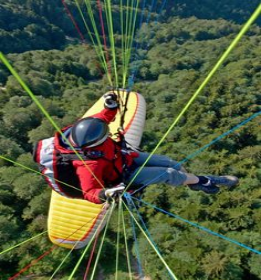Paragliding, similar to parasailing, is a wonderful sport where participants can fly through the sky, supported only by a piece of fabric. The success of this thrilling activity heavily relies on the quality and reliability of the equipment used, particularly the paragliding rope. Paragliding ropes are crucial for ensuring safety and performance, designed to withstand high tension and made from durable materials to support the weight and dynamic movements of the paraglider. High-quality paragliding ropes provide the necessary strength and flexibility, making them an essential component of your paragliding gear. So, Let’s look at Paragliding Ropes and see how they help make high flying possible.

Paragliding Rope Construction and Materials
Paragliding ropes, also known as paragliding lines, must be engineered with highly specialized materials and technologies to guarantee safety and functionality. Similar to parasailing, these stitchless sails in paragliding are constructed using up-to-date lightweight synthetic fibers like Dyneema or Aramid/Kevlar. These high-performance fibers offer the strength usually associated with steel. The excellent strength-to-weight ratio and sunlight-resistant nature of these fibers make them the best choice for paragliding ropes.
The main structure of the paragliding rope is either a kernmantle type, where the core, made of high-tensile fibers, is encased in a sheath of composite fibers that ensure strength and durability. Unsheathed lines provide reduced drag for improved glide performance. The lines have to undergo strict tests on breaking power, UV resistance, and bend cycles. They are then required to meet the high standards listed by UIAA and CEN.
Line Types and Functions
There are several types of ropes used in paragliding, each serving a specific purpose
Brake Lines: In both paragliding and parasailing, the connecting lines or brake ropes are on the trailing part of the wing and they serve as a crucial tool for the rider to achieve a streamlined ability of the glider. This is done by the application of brakes which means the the attack angle of the glider is increased and more airflow is generated but as a result, the rate of descent also slows down.
Steering Lines: More popularly known as risers, it is a line connecting the harness of the pilot to the suspension line of his or her wing. Unlike conventional flying, where the rudder is used to give the control, here a pulley system is used to have the control ie risers are used for gaining or giving away drag from the glider’s wings for steering towards left or right.
Main Lines: They represent the main tubular suspension lines that hold the suspension points of the wing and risers. They also are generally thicker and stronger to sustain the load that acts during a flight.
Stabilo Lines: These lines help maintain a stable shape and stability of the wing by connecting different points on the leading edge.
Line Maintenance and Inspection
Paragliding ropes, crafted from advanced synthetic fibers, require us to keep them clean and in good condition, regularly checking each rope through ground inspections to ensure we find the equipment secure and durable for long-term use. In air check, the pilot should regularly check for fatigue signs, smoothness, and any damage resulting from the preceding flights.
Evidence shows up in fraying, peeling, or even discoloration. In cases of such replacement of old or damaged, and for any extra in unacceptable states as quickly as possible.
Therefore, it is also essential that the replacement of lines adhere to the advice given by the manufacturer as the lines may also get damaged due to exposure to sunlight, damp conditions, or dirt.
Line Trimming and Tuning
To maximize the glider’s performance or handling qualities, experienced pilots may decide to trim or adjust their lines. This procedure modifies the shape or behavior of the wing by adjusting the length of particular lines to optimize performance. But line trimming is something that should only be done by trained experts or seasoned pilots since inaccuracies can seriously affect the glider’s performance and safety.
Conclusion
Paragliding ropes help pilots control their gliders’ flight path and direction to ensure proper flight control. It’s vital to understand the whole range of ropes, their functions, and how to take care of them. Experience a new level of confidence and precision while paragliding, akin to the exhilaration of parasailing with THISPOWER. This will make the journey enjoyable and worry-free.

thispower
Let's start working together now!
Years of professional OEM experience to meet customised needs. Fill in the enquiry form to cooperate with us and enjoy high quality service.

